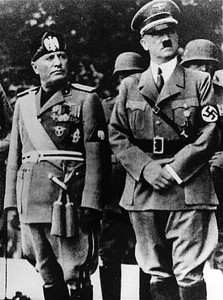Many often link Fascism and Nazism together and even believe that Nazism is a form of Fascism. However, that is completely not the case. Both ideologies although developed during the same time period with similar motives have their very own definition. Nazism derived as the ideology of the NSDAP (National Socialist German Worker’s Party), most commonly known as the Nazi Party. Meanwhile, Fascism came about Benito Mussolini’s new political movement to bring Italy back on its feet through authoritarian rule. As stated in the beginning of “Benito Mussolini: What is Fascism, 1932,” the word fascism came from the word fasces, which is the symbol of bound sticks that were used as a totem of power in ancient Rome. The image of the fasces conveys power and jurisdiction, living up to the authoritarian and strict regime that dominated Italy with the influence of Fascist ideals.
Although Fascism and Nazism are two different ideologies, they share the same origins, and as a result, share similar positions. Both Italy and Germany came out as losers of the Great War. Germany suffered with the many restrictions and reparations that were placed on them as a result of Article 231 in the Treaty of Versailles. Italy, on the other hand, was on the winning side, but suffered significant a loss since they did not receive the land that they were promised when they joined the war. As a result, both nations suffered economically, politically and socially, as well with public humiliation. Nazism and Fascism in an effort to bring Germany and Italy back on its feet respectively as powerful nations once again after suffering such great losses after the First World War. Therefore, it makes sense why there are so many similarities between both ideologies. In Benito Mussolini’s “What is Fascism, 1932,” he states that “the nineteenth century was the century of Socialism, of Liberalism, and of Democracy, it does not necessarily follow that the twentieth century must also be a century of Socialism, Liberalism and Democracy: political doctrines pass, but humanity remains, and it may rather be expected that this will be a century of authority…a century of Fascism. For if the nineteenth century was a century of individualism it may be expected that this will be the century of collectivism and hence the century of the State….” This excerpt shows the shift that was made in the twentieth century as a result of the perceived failure of Socialism, Liberalism and Democracy following the Great War and the Great Depression. Therefore, Fascism and Nazism were similar in the sense that both ideologies sought to replace individualism with collectivism. Another one of the striking similarities between Fascism and Nazism is the need for expansion. In both ideologies, expansion was the key to a prosperous nation. Lastly, extreme nationalism was another similarity between both ideologies. However, although both Fascism and Nazism shared these similarities, both are approached differently with different motives.
One of the key components of Nazism was the idea of Lebensraum. Lebensraum is directly translated as “living space.” It was the idea that territorial expansion was needed in order to gain living space for all people of the superior races. In the process of doing so, in Nazism it was believed to be a law of nature for the people of superior races to displace people of inferior races, especially if the people of the superior race were facing overpopulation in their given territories. Generally, the expansionist position of the Nazis was completely motivated by race. “The 25 Points 1920: An Early Nazi Program” repeatedly reiterated the importance for living space for all “members of the race” and place a special emphasis on clarifying who makes up the Aryan race and who does not, blatantly singling out the Jewish population. With this came the sense of extreme nationalism; Nazis believed in a greater Germany for all Germans (members of the race) and the need to collectively lead the nation to its supposed greatness. In Mussolini’s “What is Fascism, 1932” he states in regards to expansionism and nationalism that, “…For Fascism, the growth of empire, that is to say the expansion of the nation, is an essential manifestation of vitality, and its opposite a sign of decadence. Peoples which are rising, or rising again after a period of decadence, are always imperialist; and renunciation is a sign of decay and of death. Fascism is the doctrine best adapted to represent the tendencies and the aspirations of a people, like the people of Italy, who are rising again after many centuries of abasement and foreign servitude.” In this excerpt, Mussolini refers to the great defeats that Italy has suffered from in the past and makes the point that that can no longer happen again. Mussolini’s main concern is the state, and in order for Italy to rise as the most powerful power in the world, it must act with aggression and authority. With that being said, he goes on describing the need to mobilize the Italian masses in order to bring the state back on its feet. He even goes as far as personifying the state by stating, “the Fascist state is wide awake and has a will of its own.” Clearly, Mussolini creates a national character in order to help convince the Italian masses to help the state get to its supposed greatness.

